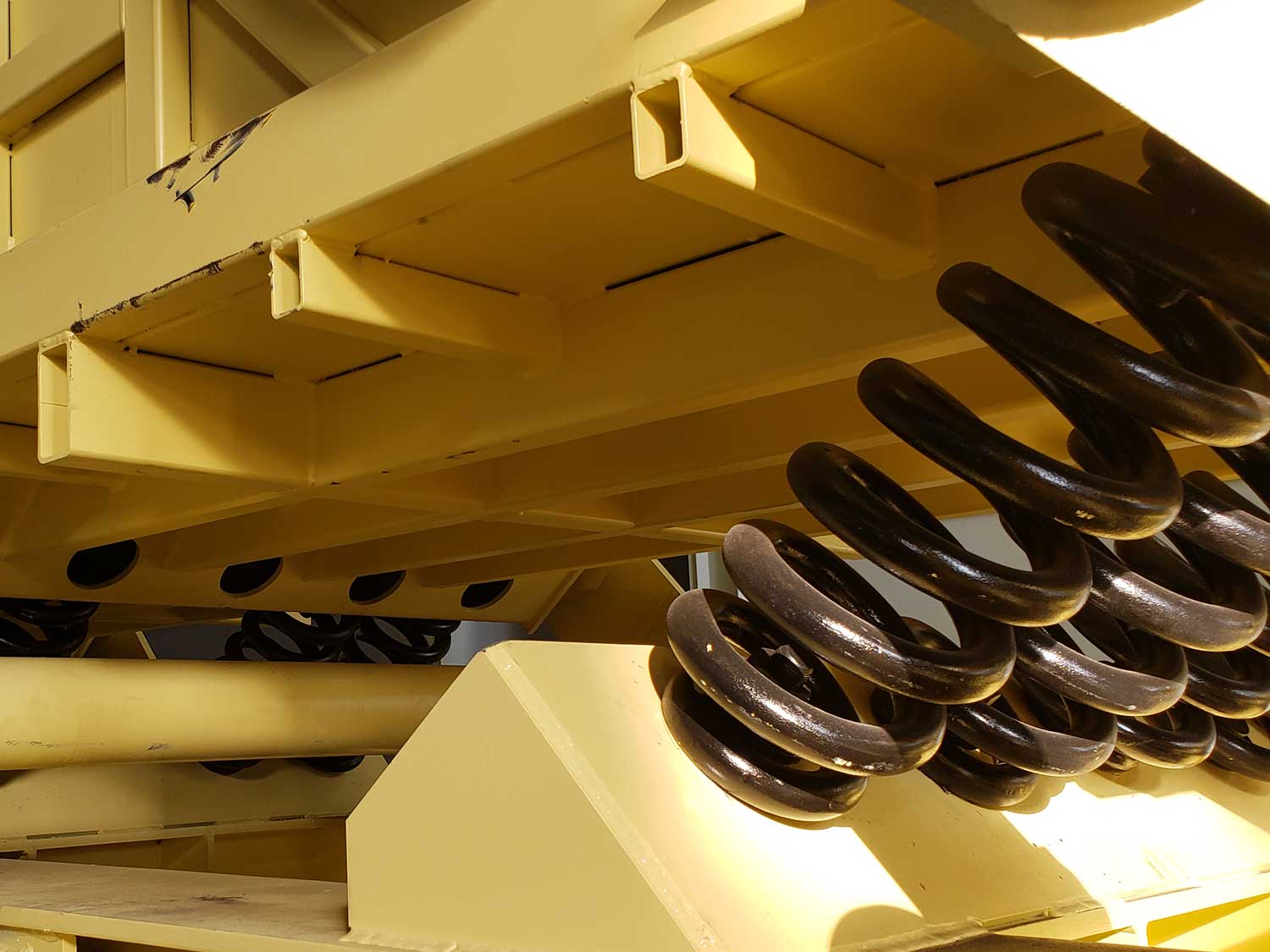In vibrating conveyors, the springs increase the efficiency of the vibratory conveyors by increasing the vibration, with some designs only needing an occasional boost of power to keep the equipment vibrating; the springs are doing most of the work once they get started. Huge conveyors can be run with a single motor because of the way the springs are taking up most of the work through the use of natural frequency principles. Springs also support the weight of the equipment plus what is being processed. They also keep vibrations from being transferred to the base and the surrounding structure, especially in isolated and balanced designs.
What are 3 types of springs in vibrating conveyors?
The 3 main types of springs used on vibratory processing equipment are steel coil springs, rubber marsh mellow springs, and leaf springs.
Steel coil springs
Steel coil springs come in a wide variety of sizes and are able to withstand huge amounts of weights, and under the right conditions are low maintenance and durable throughout a long life.
The coil springs used in the UHM vibrating conveyors are fabricated of alloy steel. Each spring assembly location includes rocker arms to control the direction of vibration. Rubber bushings are located at both ends of a malleable iron rocker arm for a nonlubricated joint. This super-duty design of coil spring assemblies, along with the heavy-duty pan construction, is built to operate in harsh environments and heavy material loading, providing long service life without maintenance.
Once a conveyor reaches its operating speed, very little drive force is required because of the pan spring system’s resonant frequency. This results in very little relative deflection between the connecting rod and the drive-spring system. This design will substantially reduce torque and horsepower requirements.
Rubber springs
The rubber springs are made of high-quality rubber and are designed to be squished down and then resume their original tube shape. Since they are rubber, they are quiet, resistant to corrosion, and can be washed down with water, but are not able to be used in high-temperature locations.
Corrosion, dirt, moisture − all this does not affect the function of the rubber springs in the least. Even if their height decreases over the years, they do not cause any fundamental problems or machine failures, as can happen with steel springs. Rubber springs can not break or splinter like metal springs and one of their big advantages is the higher safety for the operator: Exposed steel springs can be quite dangerous; many fingers have been jammed in them. This can not happen with Marsh Mellow springs.
Flat Springs
Flat Springs also called leaf springs are a flat length of material and are typically used for light-duty applications. Originally made from sheets of wood, modern-day leaf springs are made from either fiberglass and epoxy, or steel.
These flat springs are most commonly employed within the drive systems of vibratory equipment where they are loaded in bending and excited at their natural frequency. This provides the maximum deflection of the springs which translates to the maximum rate for transfer of bulk material through the vibratory conveyor or feeder. It also requires a highly fatigue-resistant material that can sustain tens of millions of load cycles without failure. Further, applications that are tuned to a particular spring performance require spring rate stability over cycle life. These springs are conservatively stressed and will have an extremely long life if the conveyor is properly installed and maintained.
Fiberglass and epoxy
The springs used in some types of vibrating conveyors are fabricated of a glass filament reinforced plastic which has extremely high flexural strength and excellent resistance to heat, moisture, and chemical exposure.
Install
Composite Leaf springs are attached either under the pan or at the side of the conveyor tray either underslung or traditionally mounted on the solid reaction base. The leaf springs/flexures are attached on mounting blocks to the conveyor, always located for easy access should they need to be changed after 5 years plus of hard duty.
Precautions for use
Over time and with use all of these spring designs can become worn out or damaged, and lose some of the springiness that the equipment relies on to operate properly.
- Springs should be checked to make sure they are the same height as all the other springs, that they are clean and do not have a build-up of dirt or grime, and that there are no signs of damage.
- Metal springs can get nicks and scratches that significantly weaken them;
- Rubber springs can get cracks or the rubber can dry out, and fiberglass can get cracks over time from the bending stresses.
All of these issues should be fixed before they cause the spring to actually fail and cause larger damages or stresses to the vibratory equipment.
